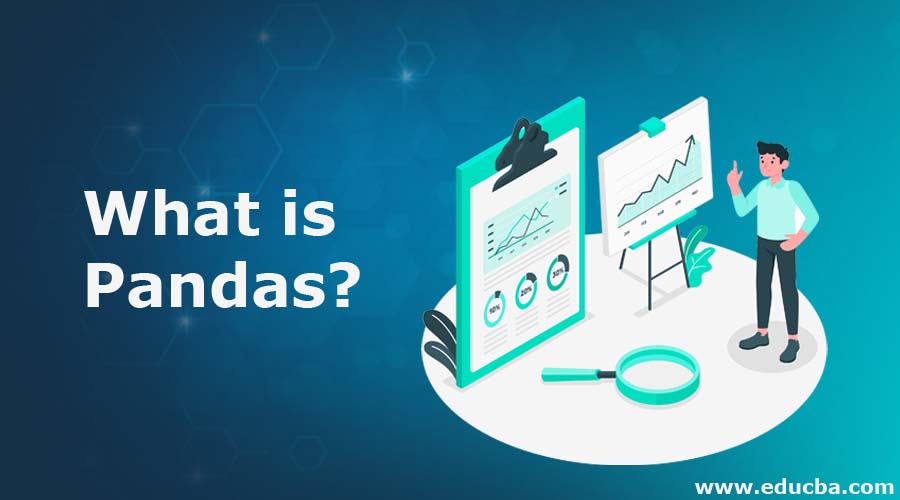Updated June 26, 2023

Introduction to Pandas
The Python library to do mathematical operations flexibly is called the Pandas library. This is an open-source library used in data analysis and manipulation so that data scientists can retrieve information from the data. It has a BSD license, and the number tables are manipulated easily. It is written in Python, Cython, and C language. It is open-source software and has high performance when compared with other libraries. The library provides tables and not arrays for memory retrieval. The data structures are easy to use.
Why do People Consider Python?
- Programmer friendliness and easy to understand
- Extensive support libraries
- Good flexibility and component Integration (Can be combined easily with applications and tools)
- Platform portability
- Opensource availability Etc…..
Work Areas of Python
- System programming (Scripting face of Python)
- Build GUI’s (Ex: thinner)
- Web Design
- Database Programming
- Scientific programming (Ex: For Analytics)
- Gaming, Image processing, Robotics Etc.
Role of Pandas in Python
Panda is an open-source setup for a Python programming language and a library licensed, offering high-performance data analysis tools and easy-to-use data structures for the Python programming language.
For achieving profound performance in data manipulation functions and analysis, segment Pandas were introduced by developer Mckinney as a part of Python. Being an open-source library.
Here the abbreviation of pandas is as below –
Pandas ==> Pan (Panel) + Das (Data)
Preparing the data and munging the same was the initial outcome of Python before introducing Panda libraries. After the introduction of Panda libraries, python began to flourish a lot in the analytics sector.
The major outcomes of the panda are:
- Analysis of data
- Preparation of data
- Data manipulation
- Data modeling
- Data analysis
The major fields in which Python with Pandas is used are as below –
- Finance
- Economics
- Analytics
Pandas Package Installation
1. Open the Installed anaconda prompt.
2. Use the below command for package installation –
pip install <packagename>
Ex: pip install pandas
3. Now, we can import the installed package into your program
Understanding Pandas
The key data structures in pandas are as below:
1. Series: One-dimensional data structure is immutable by size.
Ex :
| 10 | 23 | 56 | 17 | 52 | 61 | 73 | 90 | 26 | 72 |
Parameters :
| Parameter | Description |
| data | Constants, lists, and ndarrays |
| Index | Unique values which act as index representation |
| dtype | Represents the data type |
| copy | Copy data. false by default |
Sample Code Snippet :
import pandas as PD
import numpy as np
Test_data = np.array(['a','b','c','d'])
Sample = PD.Series(Test_data)
print sample2. Dataframe: An array that is heterogeneous and two-dimensional in format.
Ex :
| Name | Age | Gender | Rating |
| Steve | 32 | Male | 3.45 |
| Lia | 28 | Female | 4.6 |
| Vin | 45 | Male | 3.9 |
| Katie | 38 | Female | 2.78 |
Parameters :
| Parameter | Description |
| Data | Ndarrays, series, maps, list |
| Index | Unique values which act as index representation |
| Columns | Labels for columns |
| dtype | Data type values |
| copy | Used to copy data |
Sample Code snippet :
import pandas as PD
data = [[ ' Alex ' , 10 ],[ ' Bob ', 12 ],[ ' Clarke ' , 13 ]]
df = PD.DataFrame(data,columns=[' Name ' , ' Age '])
print df3. Panel: It is a heterogeneous data structure that is three-dimensional in format. Which handles data in panels.
Parameters :
| Parameter | Description |
| data | Data takes various forms like ndarray, series, map, lists, dict, constants, and also other DataFrame |
| items | axis=0 |
| major_axis | axis=1 |
| minor_axis | axis=2 |
| dtype | A data type of each column |
| copy | Copy data. Default, false |
Sample Code snippet :
import pandas as PD
import numpy as np
data = {'Item1' : PD.DataFrame(np.random.randn(4, 3)),
'Item2' : PD.DataFrame(np.random.randn(4, 2))}
p = PD.Panel(data)
printPandas Advantages
- Customizable indexed data frame objects.
- Various tools allow data to load into objects irrespective of their file formats.
- Data alignment in an efficient manner.
- Pivot dataset.
- Reshape datasets.
- Label-oriented slicing.
- Data Indexing and subsetting higher volume datasets.
- Efficiently merging high-performance datasets.
- Time series-functionality.
Required Python Pandas Skills
- Knowledge of Python web.
- ORM and related libraries familiarity.
- Database integration.
- Problem-solving ability.
- Capability to effectively organize code.
Audience for Python Pandas
- Audience with interest in learning Python.
- Individuals who aspire to become Python architects, developers, Analysts, and Testers also have relative professional roles.
- It helps to move forward the professional aspects and technical skillset of professionals who are intended to do the same.
- Python application development interested candidates.
- People who are interested to learn analytics and get expertise in this field.
Conclusion
Python has been one of the most versatile and stable languages for over a decade. In this highly stable programmatic setup, panda library programs hold a great role in boosting the data-related aspects of this widely spread language. All the major data handling-related needs of this flexible language are nicely addressed in the panda’s setup.
Recommended Articles
We hope that this EDUCBA information on “What is Pandas?” was beneficial to you. You can view EDUCBA’s recommended articles for more information.


